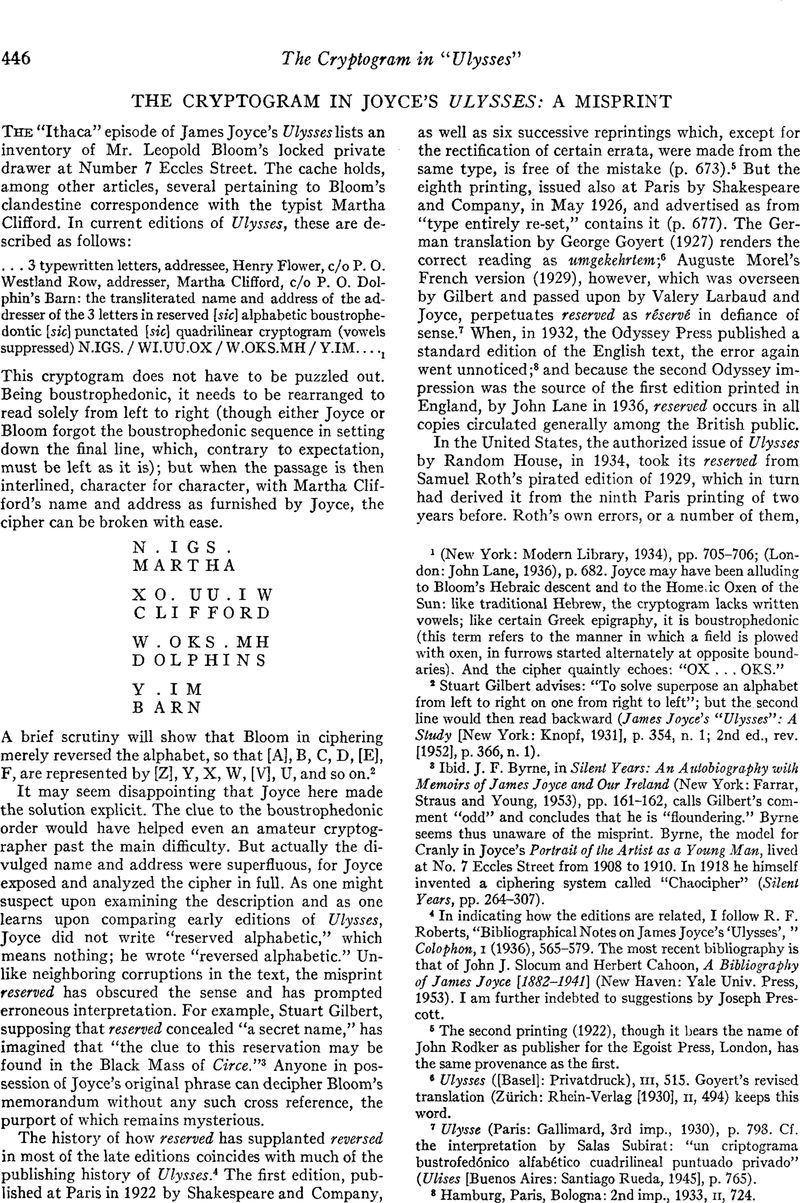No CrossRef data available.
Article contents
The Cryptogram in Joyce's Ulysses: A Misprint
Published online by Cambridge University Press: 02 December 2020
Abstract

Information
- Type
- Notes, Documents, and Critical Comment
- Information
- Copyright
- Copyright © Modern Language Association of America, 1958
References
⋆ In indicating how the editions are related, I follow R. F. Roberts, “Bibliographical Notes on James Joyce's ‘Ulysses’, ” Colophon, ? (1936), 565-579. The most recent bibliography is that of John J. Slocum and Herbert Cahoon, A Bibliography of James Joyce [1882-1941] (New Haven: Yale Univ. Press, 1953). I am further indebted to suggestions by Joseph Pres-cott.
Note 1 in page 446 (New York: Modern Library, 1934), pp. 705-706; (London: John Lane, 1936), p. 682. Joyce may have been alluding to Bloom's Hebraic descent and to the Homedc Oxen of the Sun: like traditional Hebrew, the cryptogram lacks written vowels; like certain Greek epigraphy, it is boustrophedonic (this term refers to the manner in which a field is plowed with oxen, in furrows started alternately at opposite boundaries). And the cipher quaintly echoes: “OX … OKS.”
Note 5 in page 446 Stuart Gilbert advises: “To solve superpose an alphabet from left to right on one from right to left”; but the second line would then read backward (James Joyce's “Ulysses”: A Study [New York: Knopf, 1931], p. 354, ?. 1; 2nd ed., rev. [1952], p. 366, n. 1).
Note 8 in page 446 Ibid. J. F. Byrne, in Silent Years: An Autobiography with Memoirs of James Joyce and Our Ireland (New York : Farrar, Straus and Young, 1953), pp. 161-162, calls Gilbert's comment “odd” and concludes that he is “floundering.” Byrne seems thus unaware of the misprint. Byrne, the model for Cranly in Joyce's Portrait of the Artist as a Young Man, lived at No. 7 Eccles Street from 1908 to 1910. In 1918 he himself invented a ciphering system called “Chaocipher” (Silent Years, pp. 264-307).
Note 5 in page 446 The second printing (1922), though it bears the name of John Rodker as publisher for the Egoist Press, London, has the same provenance as the first.
Note 6 in page 446 Ulysses ([Basel]: Privatdruck), in, 515. Goyert's revised translation (Zurich: Rhein-Verlag [1930], n, 494) keeps this word.
Note 7 in page 446 Ulysse (Paris: Gallimard, 3rd imp., 1930), p. 798. Cf. the interpretation by Salas Subirat: “un criptograma bustrofedonico alfabético cuadrilineal puntuado privado” (Ulises [Buenos Aires: Santiago Rueda, 1945], p. 765).
Note 8 in page 446 Hamburg, Paris, Bologna: 2nd imp., 1933, ii, 724.

